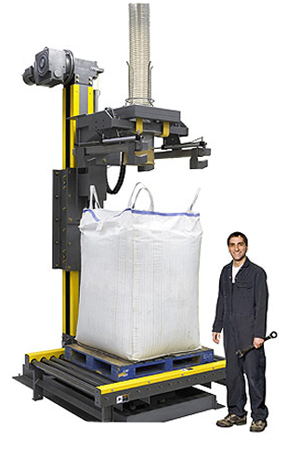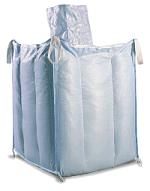Topics: bulk bag filler, bulk bag, bulk bag fillers, bulk bag handling equipment, bulk bagging equipment, Bulk Material Handling, bulk material handling equipment, filler, bulk bag filling equipment, cte filler
High Speed Bulk Bag Filling - Preweighing Design Considerations
Topics: bulk bag filler, bulk bag filling, bulk bag fillers, bulk bag handling equipment, bulk bagging equipment, Bulk Material Handling, filler, bag filler, big bag handling equipment, bulk bag filling equipment
How much product are you giving away for free in you bulk bags?
Topics: bulk bag filler, bulk bag, bulk bags, bulk bag filling, bulk bag fillers, Bulk Material Handling, dry bulk material handling, dry bulk solid, overfilling bags, profit, profitability bulk bag filling, profitability bulk bags, overfilling, overfilling bulk bags
Topics: bulk bag filler, big bag handling system, bulk bag fillers, bulk bag handling equipment, bulk bagging equipment, super sack loading equipment, big bag handling equipment, bulk bag filling equipment, bulk bag loading systems, super sack loader
Controlling Dust in Your Bulk Bag Filling Operation
Topics: bulk bag filler, bulk bag fillers, bulk bag handling equipment, bulk bagging equipment, super sack loading equipment, bulk bag filling equipment, super sack loader
One of the most overlooked keys to bulk bag filling success is training. This post reviews how properly trained operators facilitate a much more productive bulk bag filling operation.
Preparing the bulk bag for rigging.
On the surface rigging an empty bulk bag to a piece of filling equipment appears simple indeed: attach the four loops and the inlet spout and that’s it. 
Of course, those are the basic tasks, but how an operator accomplishes these tasks determines whether it is a minutes long struggle or a 30 second or less fast task.
Properly preparing the bulk bag to be rigged is the first, absolutely critical, step to minimizing bulk bag rigging time and hassle.
While a bulk bag is being filled the operator should prepare the next for rigging. Preparation involves the following steps:
- Unfold the bulk bag and expand it by stretching out the top corners.
- Unfold the inlet spout. Many operators find that folding over the lip of the inlet spout to form a collar makes it much easier to slide the spout over the fill head.
- Place the bulk bag within easy reach of the rigging position.
Rigging the bulk bag.
There is a simple and effective way to minimize motion and time when rigging a bulk bag.
- When the bulk bag filler is ready for a bulk bag to be rigged, pick up the bulk bag with the aft loops on each side held in each hand.
- Rig the aft loops first.
- Then rig the front loops.
- Only then should the inlet spout be slid over the bulk bag filler’s fill head.
Rigging a bulk bag in this sequence guarantees that the operator does not have support the full weight of the bag and wrestle with it during rigging.
Average operators can easily rig a bulk bag in 30 seconds or less following this procedure.
Using bulk bag filling equipment.
Generally, bulk bag filling equipment is easy to use when initiating a filling cycle.
However, in any operation things go wrong occasionally and operators who have been trained to properly suspend the filling operation in mid-bag and re-start the filling process after the problem has been solved minimize lost productivity.
There are times when bulk bag filling must be aborted mid-bag (due to upstream problems or a host of other reasons). Again, operators who know how to safely abort bulk bag filling and remove a partially filled bulk bag minimize down time.
Tying Off The Bulk Bag Inlet.
Many bulk bag filling operations can instantly made more productive simply by tying off the inlet spout outside of the filler instead of within it.
When a bag has been filled and is ready to be removed from the filler do not tie off the inlet spout before the bag is removed.
Instead, remove the bulk bag, rig the next and start the filling cycle, then tie off the spout of the bag that was just removed from the filler.
This applies to both automatic bag removal and forklift removal systems. Immediately initiating the next fill cycle and then tying off the just-filled bag is always the most efficient method - even if the forklift operator has to wait for the filler operator to tie off the inlet.
Operators trained to accomplish these simple tasks will consistently perform to a higher level of productivity.
Topics: bulk bag filler, bulk bag rigging, bulk bag filling, training
Sizing Bulk Bags: Filling Technology Can Save Money
 As was pointed out in an earlier blog post "How Big is A Bulk Bag", there is no such thing as a 'standard' sized bulk bag. The base or bottom seam dimensions are generally sized to fit within the mode of shipping to be used (shipping container, truck trailer, etc.) and/or to fit properly on the selected pallet.
As was pointed out in an earlier blog post "How Big is A Bulk Bag", there is no such thing as a 'standard' sized bulk bag. The base or bottom seam dimensions are generally sized to fit within the mode of shipping to be used (shipping container, truck trailer, etc.) and/or to fit properly on the selected pallet.
Depending on the bulk density of the product and its characteristics, the bulk bag's height can be significantly affected by the bulk bag filling technology employed. And, this can be a source of lucrative operating cost savings!
If your product's packed bulk density is around 35 lb/cu ft or less and its loose bulk density is more than 10-15% less than that, chances are reasonable that you are not able to achieve bulk bag weights of 2,000 to 2,205 lb using bulk bags sized to fit within a shipping container or a truck trailer.
If that's the case, maximum densification during filling can in most cases put more weight into the same sized bulk bag.
When that happens operating cost savings pile up quickly:
- Since you can put more weight in each bag, you can buy fewer bags. A 10% increase in payload weight equals a 10% reduction in the number of bags you have to buy!
- Since you can put more weight in a container or trailer there are fewer shipments that must be made and each shipment carries more weight per container. Once again, a 10% increase in payload weight reduces the number of containers thereby reducing shipping costs. This can be a HUGE cost savings!
So, if you are unable to currently achieve one ton/tonne payload weights in your bulk bags investigate using bulk bag filling technology that will mazimize densification. You may be able to put tens and even hundreds of thousands of dollars onto your plant's profit line by increasing the payload weight of your current sized bulk bags !
Topics: bulk bag filler, bulk bag dimensions, bulk bag, bulk bag size, bulk bag filling
 There are a number of factors involved in successfully stacking bulk bags. The one most overlooked is that your filled bulk bags must have a flat top!
There are a number of factors involved in successfully stacking bulk bags. The one most overlooked is that your filled bulk bags must have a flat top!
Most dry bulk solids have an angle of repose. If you pored a handfull of your product on a flat surface it would form a peak. The angle of the peak with the horizontal varies depending on the properties of the product.
When product is poured into a bulk bag it forms a peak just the same as the example above. However, if you plan to stack bulk bags it is critical that your bulk bag filling equipment densifies the product enough to produce a flat top.
A filled bulk bag with a flat top provides a stable platform on which to stack. Without it, the odds of a leaning or falling stack are greatly increased.
If you are stacking bulk bags or plan to, safety is the first priority. Make certain that your bulk bag filling equipment can produce a flat topped bag before you do anything else!
See how Control and Metering's cone table densifiction technology produces flat topped bulk bags!
Topics: bulk bag filler, bulk bag densification, bulk bag, cone table, bulk bag filling
Bulk Bag Baffles: What Are They and When To Use Them
 Baffles are pieces of plastic fabric that are sewn vertically across each of the four corners of a bulk bag. The fabric pieces have holes in them so that product can flow 'through' them and fill the corners of the bag.
Baffles are pieces of plastic fabric that are sewn vertically across each of the four corners of a bulk bag. The fabric pieces have holes in them so that product can flow 'through' them and fill the corners of the bag.
You can see the vertical seams of the baffles in the photo at the left.
There are two reasons to use baffles:
- Bulk Bag Stability. If you suffer from unstable bulk bags, baffles can improve their stability and safety.
- Bulk Bag Shape. Baffles counteract the natural tendency of a bulk bag to 'round out' - a filled bulk bag will be almost circular in horizontal cross section at a point midway up its height. Sometimes this can cause problems when trying to maximize the load in a truck trailer or a shipping container. Baffled bags are virtually square in cross section when they are filled.
Baffles are costly. They can add as much $5 - $6 dollars per bag. Therefore, their use should be carefully evaluated.
If you are considering baffles to improve bulk bag stability, compare the life cycle cost of using baffles at $5 per bag vs. the one time capital cost of filling equipment that can densify your product properly and produce a safe package with baffles.
Depending on how many bulk bags you fill per year, it doesn't take long for a properly designed bulk bag filler to pay for itself vs. having to spend $5 per bulk bag for the life of the production line.
Topics: bulk bag filler, bulk bag, bulk bag filling, bulk bag baffles
Bulk Bag Filler Packages Fertilizer in Wastewater Treatment Facilities
Topics: bulk bag filler, bulk bag fillers, bulk bag handling equipment, bulk bagging equipment, super sack loading equipment, bulk bag filling equipment, super sack loader


